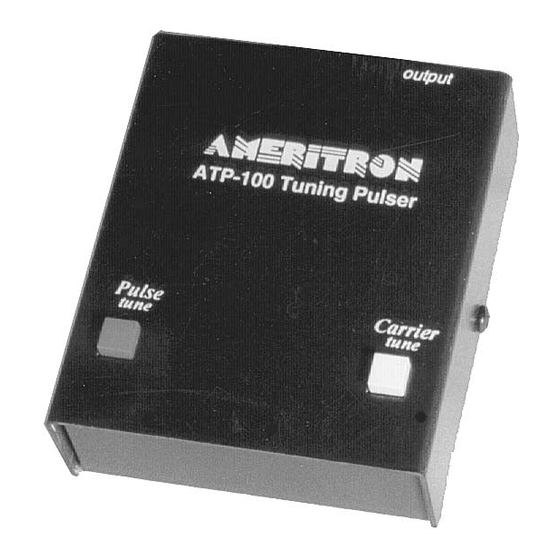AMERITRON ATP-100 Руководство по эксплуатации - Страница 4
Просмотреть онлайн или скачать pdf Руководство по эксплуатации для Усилитель AMERITRON ATP-100. AMERITRON ATP-100 8 страниц. Tuning pulser

ATP-100 Instruction Manual
Tuning Pulser
The ideal compromise (especially for tuning amplifiers) is achieved when the
PULSE RATE and DUTY CYCLE controls are near the counter-clockwise end
where the power drops off, but adjusted slightly clockwise from the point where
the peak power meter starts to fall back. If such a setting can not be found, it is a
strong indication the meter does not indicate peak power accurately.
Connecting the Ameritron ATP-100 Tuning Pulser
The Ameritron ATP-100 Tuning Pulser connects to the CW Key jack of your
exciter via the Ameritron ATP-100 Tuning Pulser
rear panel jack labeled
"Output". The Output jack is a standard RCA phono plug, with the center pin
connected to the positive voltage keying line (less than 50 volts and 100 mA)
and the outer shell grounded. If the case of the Ameritron ATP-100 Tuning
Pulser is kept isolated from ground, the Ameritron ATP-100 Tuning Pulser can
be used with negative keying line voltage radios provided radio keying line
voltages are below 25 volts. The primary concern is the shock hazard and
potential of accidentally keying the rig if the cabinet of the Ameritron ATP-100
Tuning Pulser or the operator comes in contact with grounded equipment.
WARNING: Never use the ATP-100 with negative keying line rigs
that have over 25 volts on the key jack.
Tuning Amplifiers
Nearly all power amplifiers (PA's) are properly tuned when maximum envelope
power is obtained with full exciter output. Tuning the amplifier to match exciter
peak power prevents gain compression (flat-topping), reduces splatter and
distortion, and reduces the chance of PA damage from arcing.
Maximum average power is directly related to (although considerably less than)
maximum peak power. While the lack of a good peak reading meter prevents
measurement of true peak power, virtually any RF power meter will provide a
correct indication of tuning. When the amplifier is tuned to produce maximum
average power when driven with a constant rate and duty cycle pulse, it is almost
certainly tuned for maximum peak power.
The least damaging and cleanest PA tuning condition generally occurs when the
PA is peaked slightly beyond maximum output, in a direction that OPENS or
UNMESHES the loading capacitor (this capacitor is sometimes called LOAD,
ANTENNA, COUPLING, or MATCHING).
4
